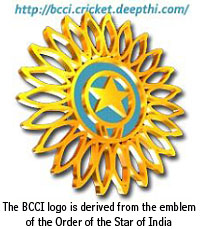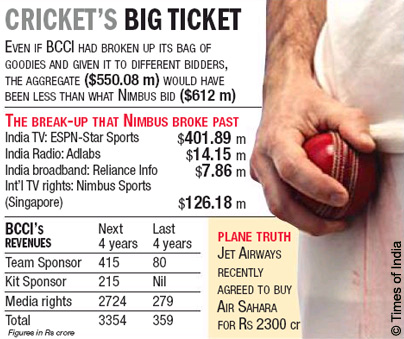

Board of Control for Cricket in India (BCCI)
Full ICC Member since 31 May 1926Latest BCCI News
BCCI is the apex governing body for cricket in India and lays down its law. Follow the links to find comprehensive news and information in BCCI.Board of Control for Cricket in India
| BCCI: Index • Latest News • BCCI related Cricket Polls • Presidents • Secretaries • Contact Info • Indian Cricket History |
Board of Control for Cricket in India
BCCI, India
 The Board of Control for Cricket in India, or BCCI, is the governing body for cricket in India. This is India's richest sporting body. The President of BCCI is Sharad Pawar (elected 29 November, 2005). Niranjan Shah is the secretary.
The Board of Control for Cricket in India, or BCCI, is the governing body for cricket in India. This is India's richest sporting body. The President of BCCI is Sharad Pawar (elected 29 November, 2005). Niranjan Shah is the secretary.
All the office-bearers for the year 2004-05, were elected at the annual general meeting of the Board held in Kolkata.
On January 10, 2005, the Supreme Court of India ordered the removal of Jagmohan Dalmiya from the post of patron-in-chief of BCCI and also asked the board to complete its annual general meeting (AGM) which had been adjourned on September 30, 2004.
The legality of the office-bearer's election at the board's annual general meeting (AGM) held on September 29, 2004 is subjudice.
BCCI Cricket News February 2006
Further delay over Trophy venues
Feb 22, 2006
India's cricket board has still to decide the venues for the ICC Champions Trophy, set to begin on 7 October.
Delhi and Mumbai (Bombay) backed out as venues because of their own specific advertising and sponsors ticket deals. Jaipur, Mohali, Eden Gardens and the Mumbai's Brabourne Stadium are thought to have been short-listed.
BCCI treasurer N Srinivasan said: "There are additional costs and other matters related to it which need to be worked out. This will be done soon." BCCI bosses, who expressed opposition to the future of the bi-annual event, are currently embroiled in rows over the actions of former chief Jagmohan Dalmiya. Another possible point of controversy surrounds the extra cost involved in staging matches at four separate venues, with the International Cricket Council expecting this to be met by the BCCI.
India board begins Dalmiya probe
Feb 21, 2006
The Board of Control for Cricket in India is to launch an inquiry into its former president Jagmohan Dalmiya.
He has been asked to explain his handling of the board's funds during his period in charge and has been given a week to reply.
Some of the issues date back to the 1996 Cricket World Cup, a tournament co-hosted by India, Pakistan and winners Sri Lanka. But Dalmiya told the BBC the charges levelled against him were baseless.
He was the most powerful man in Indian cricket for two decades, and helped the board become the world's richest sporting body. Dalmiya stepped down as president in 2004 but used his vote to ensure his chosen candidate, Ranbir Singh Mahendra, succeeded him.
Mahendra's term of office lasted only one year and he was ousted by rival Sharad Pawar last November. Pawar's choice as treasurer, N Srinivasan, said Dalmiya had been asked to furnish all details regarding the board's bank accounts.
"It is a matter of grave concern and some action has to be taken. The process and timing of the action is to be decided by the board president," he added. Lalit Modi, vice-president of the Board, went further, claiming alleged misuse of funds pertaining to the 1996 World Cup "may run to millions of dollars".
But in response, Dalmiya claims some of the current board members are trying to malign him. He has promised to give a detailed response to the allegations in due course.

Bindra accuses Dalmiya of underselling BCCI
Feb 18, 2006
Board of Control for Cricket in India (BCCI), marketing sub-committee member I S Bindra today came down heavily on former chief Jagmohan Dalmiya, stating that the Board had lost money under his tenure because of ''vested interests''. He was speaking to reporters after the announcement of Nimbus winning the Global media rights of the cricket board.
With the awarding of the rights to Nimbus, who bid the highest amount (612 million dollars) for the next four years from March 1 this year to March 31, 2010, the coffers of BCCI's total income from sale of rights and sponsorship amounts has swelled to Rs 3,354 crore, compared to Rs 359 crore it earned the previous four years. speaking to reporters after the announcement of Nimbus winning the Global media rights of the cricket board. Bindra alleged that the previous BCCI committee had undersold the rights, which resulted in it not receiving the deserved amount. ''In the last 10 years, I have it on record that the BCCI was underselling its rights grossly. I pointed it out long back, but I was suspended,'' he said.
Dalmiya might get disciplined
Feb 11 2006
Former BCCI president Jagmohan Dalmiya is likely to face disciplinary action if he fails to handover relevant files of Income and Expenditure relating to the 1996 World Cup which was held jointly by Pakistan, Sri Lanka and India. Talking to DNA, a Board official said: "BCCI has already changed the signatory of the 1996 World Cup account (No: 1223) with the Indian Overseas Bank, Kolkata. A huge amount is lying in that account and Dalmiya has been the lone signatory since it was opened.Dalmiya, however denied the allegations.
BCCI to appoint single entity for telecast rights
Feb 10 2006
The Indian cricket board Friday said that it would sell both terrestrial and global satellite telecast rights for all matches involving the Indian cricket team to a single entity.
This would spare the Board of Control for Cricket in India (BCCI) the inconvenience of negotiating with separate entities for terrestrial and global rights."The recent ruling of the Supreme Court regarding broadcasting rights on Doordarshan has changed the dynamics of the situation and as a result BCCI decided to do away with a separate tender for Doordarshan marketing only," said Lalit Modi, chairman of BCCI's marketing sub-committee.
Cricket in India
Cricket is the unofficial national sport of India, and its development has been closely tied up with the history of the country, mirroring many of the political and cultural developments around issues such as race, caste, religion and nationality. Though cricket is indubitably the most popular sport in India, it is not the nation's national sport (a distinction held by field hockey).Cricket, like field hockey, was first introduced to India by the British. The earliest recorded match was played in 17211 by British sailors on shore leave. With the expansion of British rule throughout the subcontinent, the British took the game with them wherever they went. However, the early history of the game was focused largely on the large cities, particularly Bombay (now Mumbai).
The first Indians to play the game at a high level were the Parsi minority in Bombay. Beginning in 1892, an annual match was played between the Parsis and the Europeans. In 1907, this became a triangular tournament with the Hindus fielding a team, and in 1912 a Muslim team entered what was for twenty years the biggest tournament in Indiathe Bombay Quadrangular.
Among the biggest stars in the early years of Indian cricket were the four Palwankar brothers, Shivram, Ganpat and Vithal but particularly the slow left-arm bowler, Palwankar Baloo. This was particularly noteworthy as the Palwankars were from one of the untouchable castes. Treated as equals on the cricket field, off-field they often faced discrimination. This changed slowly; however, Palwankar Vithal did eventually captain the Hindu team in the quadrangular.
The formation of the Board of Control for Cricket in India in 1929 led to a first Test match with England three years later. In 1935, the Ranji Trophy began; it continues to the present as the leading regional tournament in India, with each state fielding a team. The trophy was a deliberate attempt to avoid the communalism of the quadrangular tournament.
The Indian cricket team has won one Cricket World Cup, in 1983. India also reached the finals in 2003, but lost to Australia. In recent years, Indian cricket has been marked by the intense and occasionally violent rivalry with Pakistan. Furthermore, there were several scandals related to match fixing and gambling, but these were not restricted to India; they plagued several different teams.
International cricket in India generally does not follow a fixed pattern like, for example, the English schedule under which the nation tours other countries during winter and plays at home during the summer. Generally, there has recently been a tendency to play more one-day matches than Test matches.
Ranji Trophy
Founded as 'The Cricket Championship of India' at a meeting of the Board of Control for Cricket in India in July 1934. The first Ranji Trophy fixtures took place in the 1934-35 season. Syed Mohammed Hadi of Hyderabad was the first batsman to score a century in the tournament. The Trophy was donated by H.H. Sir Bhupendra Singh Mahinder Baha-dur, Maharajah of Patiala in memory of His late Highness Sir Ranjitsinhji Vibhaji of Nawanagar. In the main, the Ranji Trophy is composed of teams representing the states that make up India. As the political states have multiplied, so have cricket teams, but not every state has a team. Some states have more than one cricket team, e.g. Maharashtra and Gujarat. There are also 'odd' teams like Railways, and Services representing the armed forces. The various teams used to be grouped into zones - North, West, East, Central and South - and the initial matches are played on a league basis within the zones. The top two (till 1991-92), top three teams from each zone then play in a national knock-out competition. Starting with the 2002-03 season, the zonal system has been abandoned and a two-division structure has been adopted with two teams being promoted from the plate league and two relegated from the elite league. If the knockout matches are not finished they are decided on the first-innings lead.Irani Trophy
The Irani Trophy tournament was conceived during the 1959-60 season to mark the completion of 25 years of the Ranji Trophy championship and was named after the late Z.R. Irani, who was associated with the Board of Control for Cricket in India (BCCI) from its inception in 1928, till his death in 1970. The first match, played between the Ranji Trophy champions and the Rest of India was played in 1959-60 with the trophy being instituted in the name of Zal Irani, long time treasurer of the Board of Control for Cricket in India and a keen patron of the game. For the first few years, it was played at the fag end of the season. Realising the importance of the fixture, the BCCI moved it to the beginning of the season. Since 1965-66, it has traditionally heralded the start of the new domestic season. The Irani Trophy game ranks very high in popularity and importance. It is one of the few domestic matches that is followed with keen interest by cricket lovers in the country. Leading players take part in the game which has often been a sort of selection trial to pick the Indian team for foreign tours.Duleep Trophy
The Duleep Trophy competition was started by the Board of Control for Cricket in India in 1961-62 with the aim of providing a greater competitive edge in domestic cricket - because, apart from the knock-out stages of the Ranji Trophy, that competition proved predictable, with Bombay winning for fifteen consecutive years. The Duleep was also meant to help the selectors in assessing form. The original format was that five teams, drawn from the five zones, play each other on a knock-out basis. From the 1993-94 season, the competition has been converted to a league format.Harbhajan Singh Memorabilia
Singh's Magnificent Hat Trick
Own a piece of Indian Cricket History
 On the 1st Day of the 2nd Test, India versus Australia, in March 2001, at Eden Gardens in Kolkata, Harbhajan Singh achieved what no other Indian cricketer had ever done - he snared a magnificent Hat Trick.
On the 1st Day of the 2nd Test, India versus Australia, in March 2001, at Eden Gardens in Kolkata, Harbhajan Singh achieved what no other Indian cricketer had ever done - he snared a magnificent Hat Trick.
Limited Edition Magnificent photographic collage of the three dismissals with the hat trick at Calcutta capturing photograph in each piece being personally signed by Harbhajan Singh. Each piece .encased in a timber frame with Perspex glazing and is supported by A-Tag microchip authentication technology, and comes complete with a Certificate of Authenticity.
 Buy now / Read more / Other cricket memorabilia
Buy now / Read more / Other cricket memorabilia



